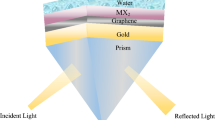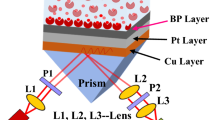Abstract
The plasmonic materials and phenomena are widely studies and applied in multiple fields for an extended time. One among the foremost promising applications is within the engineering of biosensor devices, Diseases of the red blood cells are among the diseases of the blood. Anemia as an example is an abnormal reduction within the concentration of hemoglobin within the blood. When the amount of red blood cells decreases, so does the concentration of hemoglobin. The tissues and organs not receive sufficient oxygen to work normally. This numerical study will give a contribution or approach on the behaviour of blood with surface plasmons resonance SPR by analysing the performance of SPR with any changes in hemoglobin concentrations (refractive index) for the application of technique in the detection of blood diseases.








Similar content being viewed by others
References
Ambartsumyan, O., Gribanyov, D., Kukushkin, V., Kopylov, A.: SERS-based biosensors for virus determination with Oligonucleotides as recognition elements. Int. J. Mol. Sci. 21(9), pp.1–15, (2020)
Belkin, S., Roda, A.: Handbook of Cell Biosensors. Springer International Publishing, Cham (2020). https://doi.org/10.1007/978-3-319-47405-2
Bhavsar, K., Prabhu, R.: Investigations on sensitivity enhancement of SPR biosensor using tunable wavelength and graphene layers. IOP Conf. Ser. Mater. Sci. Eng. 499(1) (2019). doi: https://doi.org/10.1088/1757-899X/499/1/012008
Biran, I., Rissin, D.M., Ron, E.Z., Walt, D.R.: Optical imaging fiber-based live bacterial cell array biosensor. Anal. Biochem. 315(1), 106–113 (2003). doi: https://doi.org/10.1016/S0003-2697(02)00700-5
Chen, C., Wang, J.: Optical biosensors: an exhaustive and comprehensive review. Analyst. 145(5), 1605–1628 (2020). doi: https://doi.org/10.1039/C9AN01998G
Chen, S., Lin, C.: Sensitivity comparison of graphene based surface plasmon resonance biosensor with au, Ag and Cu in the visible region. Mater. Res. Express. 6(5), 056503 (2019). https://doi.org/10.1088/2053-1591/ab009d
Damborský, P., Švitel, J., Katrlík, J.: Optical biosensors. Essays Biochem. 60(1), 91–100 (2016). doi: https://doi.org/10.1042/EBC20150010
Friebel, M., Meinke, M.: Model function to calculate the refractive index of native hemoglobin in the wavelength range of 250–1100 nm dependent on concentration. Appl. Opt. 45(12), 2838–2842 (2006). doi: https://doi.org/10.1364/AO.45.002838
Grumann, J.D.M., Dube, M., Brefka, T., Steigert, J., Riegger, L., Brenner, T., Mittmann, K., “Direct hemoglobin measurement by monolithically integrated optical beam guidance. 13th International Conference of Solid-State Sensors, Actuators Microsystems, June 5–9, Seoul, Korea. 2, pp. 1106–1109 (2005)
Guerrini, L., Garcia-Rico, E., O’Loghlen, A., Giannini, V., Alvarez-Puebla, R.A.: Surface-enhanced Raman scattering (SERS) spectroscopy for sensing and characterization of exosomes in cancer diagnosis. Cancers. 13(9) (2021). https://doi.org/10.3390/cancers13092179
Hegde, G.: Investigations on sensitivity enhancement of SPR biosensor using tunable wavelength and graphene layers Investigations on sensitivity enhancement of SPR biosensor using tunable wavelength and graphene layers. In IOP Conference Series: Materials Science and Engineering https://doi.org/10.1088/1757-899X/499/1/012008
Homola, J.: Surface plasmon resonance sensors for detection of chemical and biological species. Chem. Rev. 108(2), 462–493 (2008). doi: https://doi.org/10.1021/cr068107d
Isaacs, S., Abdulhalim, I.: Long range surface plasmon resonance with ultra-high penetration depth for self-referenced sensing and ultra-low detection limit using diverging beam approach. Appl. Phys. Lett. 106(19) (2015). https://doi.org/10.1063/1.4921200
Jia, K., Eltzov, E., Toury, T., Marks, R.S., Ionescu, R.E.: A lower limit of detection for atrazine was obtained using bioluminescent reporter bacteria via a lower incubation temperature. Ecotoxicol. Environ. Saf. 84, 221–226 (2012). https://doi.org/10.1016/j.ecoenv.2012.07.009
Johansen, K., Arwin, H., Lundström, I., Liedberg, B.: Imaging surface plasmon resonance sensor based on multiple wavelengths: sensitivity considerations. Rev. Sci. Instrum. 71(9), 3530–3538 (2000). doi: https://doi.org/10.1063/1.1287631
Khansili, N., Rattu, G., Krishna, P.M.: Sensors and actuators B: chemical label-free optical biosensors for food and biological sensor applications. Sens. Actuators B Chem. 265, 35–49 (2018). doi: https://doi.org/10.1016/j.snb.2018.03.004
Kumar, S., Singh, R.: Recent optical sensing technologies for the detection of various biomolecules: review. Optics and Laser Technology, vol. 134, Elsevier Ltd., Amsterdam, p. 106620, (2020). https://doi.org/10.1016/j.optlastec.2020.106620
Li, X., Chen, N., Zhou, X., Gong, P.: A review of specialty fiber biosensors based on interferometer configuration. no. March. 1–19 (2021). doi: https://doi.org/10.1002/jbio.202100068
Liang, X., et al.: Carbon-based SERS biosensor: from substrate design to sensing and bioapplication. NPG Asia Mater. 13(1), 8 (2021). doi: https://doi.org/10.1038/s41427-020-00278-5
Lukose, J., Chidangil, S., George, S.D.: Optical technologies for the detection of viruses like COVID-19: progress and prospects. Biosensors and Bioelectronics, vol. 178, Elsevier B.V., Amsterdam, p. 113004, (2021). https://doi.org/10.1016/j.bios.2021.113004
Maddali, H., Miles, C.E., Kohn, J., O’Carroll, D.M.: Optical biosensors for virus detection: prospects for SARS-CoV-2/COVID-19. ChemBioChem. 22(7), 1176–1189 (2021). https://doi.org/10.1002/cbic.202000744
Muhammad, M., Huang, Q.: A review of aptamer-based SERS biosensors: design strategies and applications. Talanta 227 (2020). Elsevier B.V., Amsterdam, p. 122188 (2021). https://doi.org/10.1016/j.talanta.2021.122188
Naresh, V., Lee, N.: A review on biosensors and recent development of nanostructured materials-enabled biosensors. Sens. Switz. 21(4), 1–35 (2021). https://doi.org/10.3390/s21041109
Park, J.H., Cho, Y.W., Kim, T.H.: Recent advances in surface Plasmon resonance sensors for sensitive optical detection of pathogens. Biosensors. 12(3) (2022). https://doi.org/10.3390/bios12030180
Prahl, S.: Optical absorption of hemoglobin. Oregon Med. Laser Cent, vol. 15, pp. 770–774, [Online]. Available: (1999). http://omlc.ogi.edu/spectra/hemoglobin.
R. Barer, Refractometry and interferometry of living cells. J. Opt. Soc. Am. 47(6), pp.545–556, (1957). https://doi.org/10.1364/JOSA.47.000545
Safina, G., Duran, I.B., Alasel, M., Danielsson, B.: Surface plasmon resonance for real-time study of lectin–carbohydrate interactions for the differentiation and identification of glycoproteins. Talanta. 84(5), 1284–1290 (2011). doi: https://doi.org/10.1016/j.talanta.2011.01.030
Safina, G.: Application of surface plasmon resonance for the detection of carbohydrates, glycoconjugates, and measurement of the carbohydrate-specific interactions: a comparison with conventional analytical techniques. A critical review. Analytica Chimica Acta, vol. 712. Elsevier B.V., Amsterdam, pp. 9–29, (2012). https://doi.org/10.1016/j.aca.2011.11.016
Schasfoort, R.B.M. (ed): Handbook of Surface Plasmon Resonance, 2nd Edn. Royal Society of Chemistry, Cambridge (2017). https://doi.org/10.1039/9781788010283
Sharma, A.K.: Plasmonic biosensor for detection of hemoglobin concentration in human blood: design considerations. J. Appl. Phys. 114(4) (2013). https://doi.org/10.1063/1.4816272
Sharma, A.K., Jha, R., Pattanaik, H.S.: Design considerations for surface plasmon resonance based detection of human blood group in near infrared. J. Appl. Phys. 107(3) (2010). https://doi.org/10.1063/1.3298503
Sharma, A.K.: Plasmonic biosensor for detection of hemoglobin concentration in human blood: design considerations. J. Appl. Phys. 114(4), 044701 (2013). https://doi.org/10.1063/1.4816272
Taitt, C.R., Anderson, G.P., Ligler, F.S.: Evanescent wave fluorescence biosensors: advances of the last decade. Biosens. Bioelectron. 76, 103–112 (2016). https://doi.org/10.1016/j.bios.2015.07.040
Tang, Y., Zeng, X., Liang, J.: Surface plasmon resonance: an introduction to a surface spectroscopy technique. J. Chem. Educ. 87(7), 742–746 (2010). doi: https://doi.org/10.1021/ed100186y
Taparia, N., Platten, K.C., Anderson, K.B., Sniadecki, N.J.: A microfluidic approach for hemoglobin detection in whole blood. AIP Adv. 7(10) (2017). https://doi.org/10.1063/1.4997185
Walter, J.G., Eilers, A., Alwis, L.S.M., Roth, B.W., Bremer, K.: Spr biosensor based on polymer multi-mode optical waveguide and nanoparticle signal enhancement. Sens. (Switzerland). 20(10), 1–11 (2020). doi: https://doi.org/10.3390/s20102889
Yadav, S., et al.: SERS based lateral flow immunoassay for point-of-care detection of SARS-CoV-2 in clinical samples. A4CS Appl. Bio. Mater.4, pp. 2974–2995 (2021). https://doi.org/10.1021/acsabm.1c00102
Zajíc, J., Ripp, S., Trögl, J., Kuncová, G., Pospíšilová, M.: Repetitive detection of aromatic hydrocarbon contaminants with bioluminescent bioreporters attached on tapered optical fiber elements. Sens. Basel. 20(11), 3237 (Jun. 2020). doi: https://doi.org/10.3390/s20113237
Zaytseva, N., Miller, W., Goral, V., Hepburn, J., Fang, Y.: Microfluidic resonant waveguide grating biosensor system for whole cell sensing. Appl. Phys. Lett, vol. 98, no. 16, p. 163703, Apr. doi: (2011). https://doi.org/10.1063/1.3582611
Zhang, W., Jiang, L., Piper, J.A., Wang, Y.: SERS Nanotags and their applications in Biosensing and Bioimaging. J. Anal. Test 2(4), 26–44 (2018). https://doi.org/10.1007/s41664-018-0053-9
Funding
The authors have not disclosed any funding.
Author information
Authors and Affiliations
Contributions
H.I.M. reports article publishing charges was provided by University of Ferhat Abbas Setif 1 Institute of Optics and Precision Mechanics. H.M.I. reports a relationship with University of Ferhat Abbas Setif 1 Institute of Optics and Precision Mechanics that includes: board membership. Teacher Researcher at Mohamed Boudiaf University of Msila.
Corresponding author
Ethics declarations
Conflict of interest
The authors declare that they have no known competing financial interests or personal relationships that could have appeared to influence the work reported in this paper.
Ethical approval
The paper was prepared and approved by all the authors. They are all aware of its contents and approve its submission to the Optical and Quantum Electronics. In addition, they state that this manuscript has not been published and that there are no plans to publish it elsewhere.
Additional information
Publisher’s Note
Springer Nature remains neutral with regard to jurisdictional claims in published maps and institutional affiliations.
Rights and permissions
Springer Nature or its licensor (e.g. a society or other partner) holds exclusive rights to this article under a publishing agreement with the author(s) or other rightsholder(s); author self-archiving of the accepted manuscript version of this article is solely governed by the terms of such publishing agreement and applicable law.
About this article
Cite this article
Habia, M.I., Manallah, A. & Ayadi, K. Plasmonic biosensor for the study of blood diseases by analysis of hemoglobin concentration. Opt Quant Electron 55, 234 (2023). https://doi.org/10.1007/s11082-022-04503-z
Received:
Accepted:
Published:
DOI: https://doi.org/10.1007/s11082-022-04503-z




